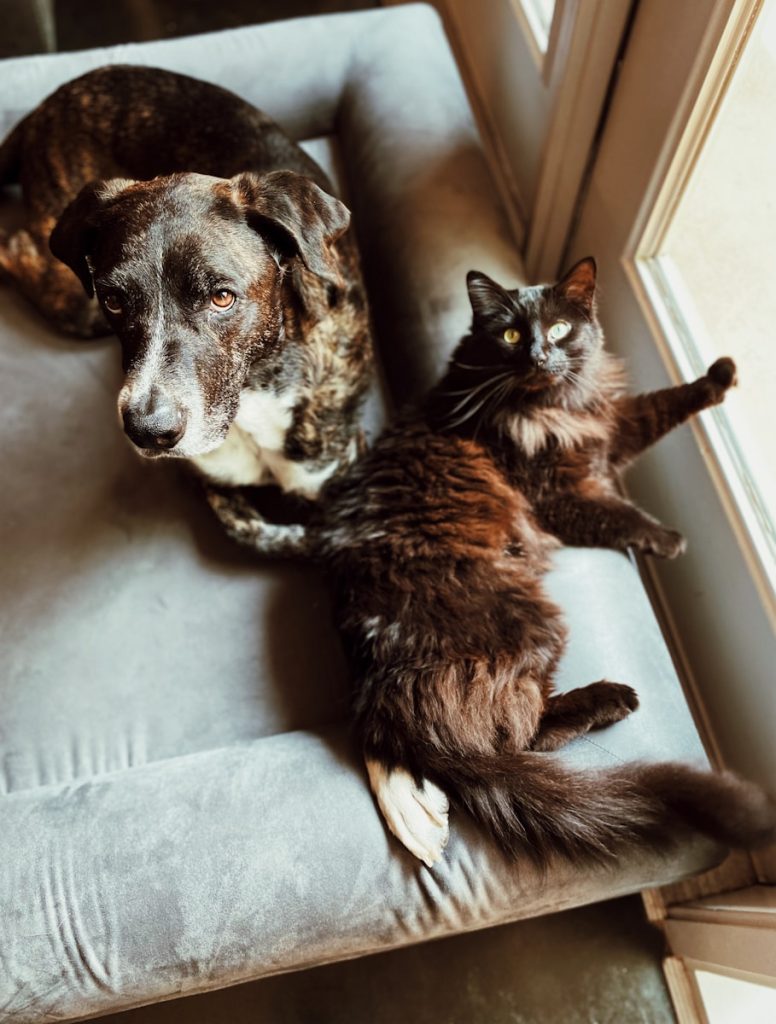Bringing a new pet into a multi-species household is an exciting time, but it also requires patience, understanding, and a strategic approach – especially when introducing dogs and cats. While the dream of harmonious cohabitation is achievable, rushing the process can lead to stress and even dangerous situations for your furry family members.
We hear you! Many of you have shared your experiences and challenges. Below we compiled 5 key elements that combine effective strategies to help you navigate this delicate introduction period. Let’s dive into creating a peaceful multi-species home.

1) Laying the Groundwork: Setting the Stage for Success
Before the first face-to-face meeting, it’s advantageous to establish a foundation of safety and positive associations. Again, take your time to set things up so you can control the situation as much as possible. Patience, patience and more patience.
- Scent Swapping: Begin by allowing your dog and cat to get used to each other’s scent without direct interaction. Swap their bedding, toys, or even just cloths or towels rubbed on them. This allows them to gather information about the new housemate in a non-threatening way.
- Separate Spaces: Ensure each animal has their own designated safe zone. For your cat, this could be a room blocked off with a baby gate, high shelves, cat trees, and hiding spots that the dog cannot access. Provide resources like a litter box, food, and water in a totally dog-inaccessible space to allow your feline friend to retreat and feel secure. This is paramount in reducing stress and preventing feelings of being trapped.
- Controlled Visual Introductions: Once they seem relatively calm with each other’s scent, you can introduce controlled visual interactions. Keep your dog on a leash and allow them to see the cat from a distance, perhaps through a slightly open door or a secure baby gate. Keep these initial glimpses short and positive. Be careful if you’re holding your cat that they have enough distance so they don’t panic and scratch you trying to get away.
2) The Power of Positive Reinforcement
Creating positive associations is key. This is where consistent training and rewarding desired behaviours come into play. Take your time. Feel free to use a clicker if your pets are already familiar with the association, if not (or if it’s not handy) use a verbal marker.
- High-Value Treats: Keep high-value treats readily available for both species. Rewarding your dog immediately when they exhibit calm behaviour around the cat is incredibly effective. When your dog looks at the cat and remains still, say a marker word like “good” or “yep”. This helps them understand that calm behaviour in the presence of the cat earns them something positive.
- Leash Control: During initial interactions in the same room, always keep your dog on a leash. This allows you to maintain control and prevent chasing. Even if your dog’s intentions aren’t to harm, a chase can be terrifying for a cat.
- Gradual Proximity: Slowly and incrementally decrease the distance between your dog and cat, always under your direct supervision and with the dog on a leash. If either animal shows signs of stress (for cats: growling, hissing, flattened ears, arched back; for dogs: raised hackles, growling, showing teeth, stiffening, freezing), increase the distance again. Remember, it’s better to go slower than to push them too quickly.
- Shared Positive Experiences: If both animals are calm in each other’s presence, consider rewarding them simultaneously with treats. This can help them associate the other animal with positive experiences.
- Once both are exhibiting calm body language, allow them to sniff each other through a baby gate or x-pen briefly, then call them away and reward separately
3) Creating a Harmonious Environment
Beyond direct interactions, the overall environment plays a significant role in their ability to coexist peacefully. It is well worth the effort and time – don’t skip this step!
- Multiple Escape Routes: Ensure your cat always has multiple escape routes and high perches available throughout the house. This allows them to feel in control of their environment and avoid feeling cornered or pinned down.
- Resource Management: Avoid competition for resources. Provide separate food and water bowls in different locations, especially the cat’s safe zone.
- Supervision is Key: Even after they seem to be getting along, always supervise their interactions, especially in the initial months. Never leave them alone together unsupervised until you are absolutely confident in their compatibility.
4) Patience is Your Superpower
Seriously – did you notice the emphasis on patience with the process?? Go slower than you think you need to. Every animal is an individual, and the timeline for successful integration will vary. Some dogs and cats may become best friends quickly, while others may take months or even longer to reach a comfortable coexistence.
5) When to Seek Professional Guidance
If you are struggling with the introduction process, or if you are seeing signs of aggression or significant stress in either your dog or cat, don’t hesitate to seek professional help. A qualified dog trainer or a veterinary behaviourist can provide tailored guidance and support to ensure a safe and positive outcome for everyone. Even a short phone consultation like our 30-minute training calls can offer valuable insights and strategies specific to your situation.
Introducing dogs and cats successfully requires time, patience, consistency, and a focus on creating positive associations and safe environments. By following these steps and responding to your animal’s cues, you can build a foundation for a peaceful and happy multi-species home.
Looking for more dog training tips or classes to help your pup thrive? Explore our programs here.

